Health Advocacy & SDG 8: Unemployment and Economic Growth Analysis
VerifiedAdded on 2023/06/03
|10
|2821
|68
Essay
AI Summary
This essay explores the critical need for health advocacy in addressing unemployment and limited job opportunities, particularly among youth, within the framework of the UN's Sustainable Development Goal 8, which focuses on promoting inclusive, sustainable economic growth and full employment. It highlights the association between unemployment and adverse physical and mental health outcomes, emphasizing the importance of problem analysis using the Bacchi framework. The essay advocates for the application of the Policy Windows theory of change framework to drive health advocacy efforts, suggesting strategies such as conducting rapid surveys through NGOs to understand the issue's magnitude and leveraging social media campaigns and media advocacy to influence political attention. Furthermore, it underscores the significance of collaboration among employment agencies, government bodies, and public health agencies to build capacity, change social norms, and rectify social determinants that impede employment opportunities, ultimately advocating for a well-being of citizens.
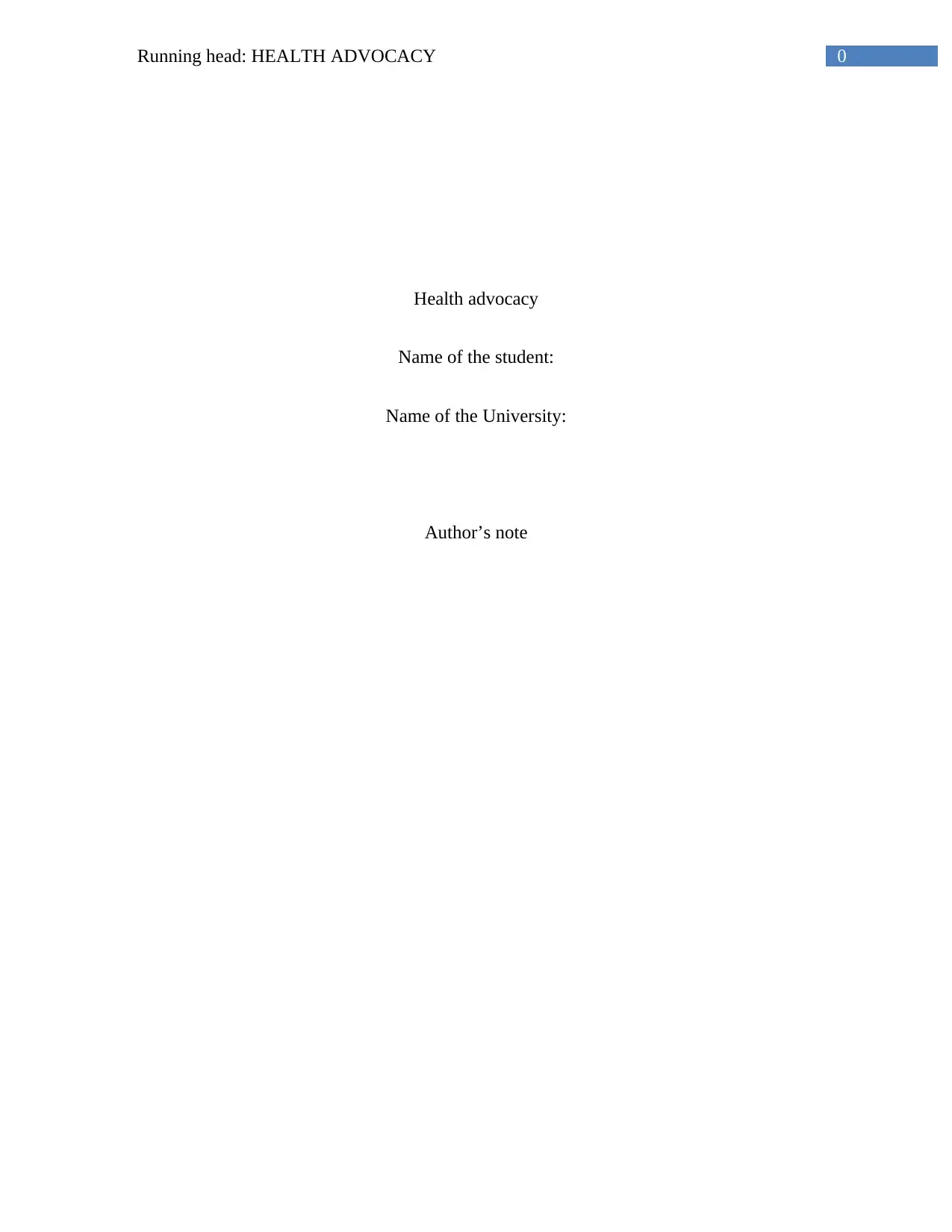
0Running head: HEALTH ADVOCACY
Health advocacy
Name of the student:
Name of the University:
Author’s note
Health advocacy
Name of the student:
Name of the University:
Author’s note
Paraphrase This Document
Need a fresh take? Get an instant paraphrase of this document with our AI Paraphraser
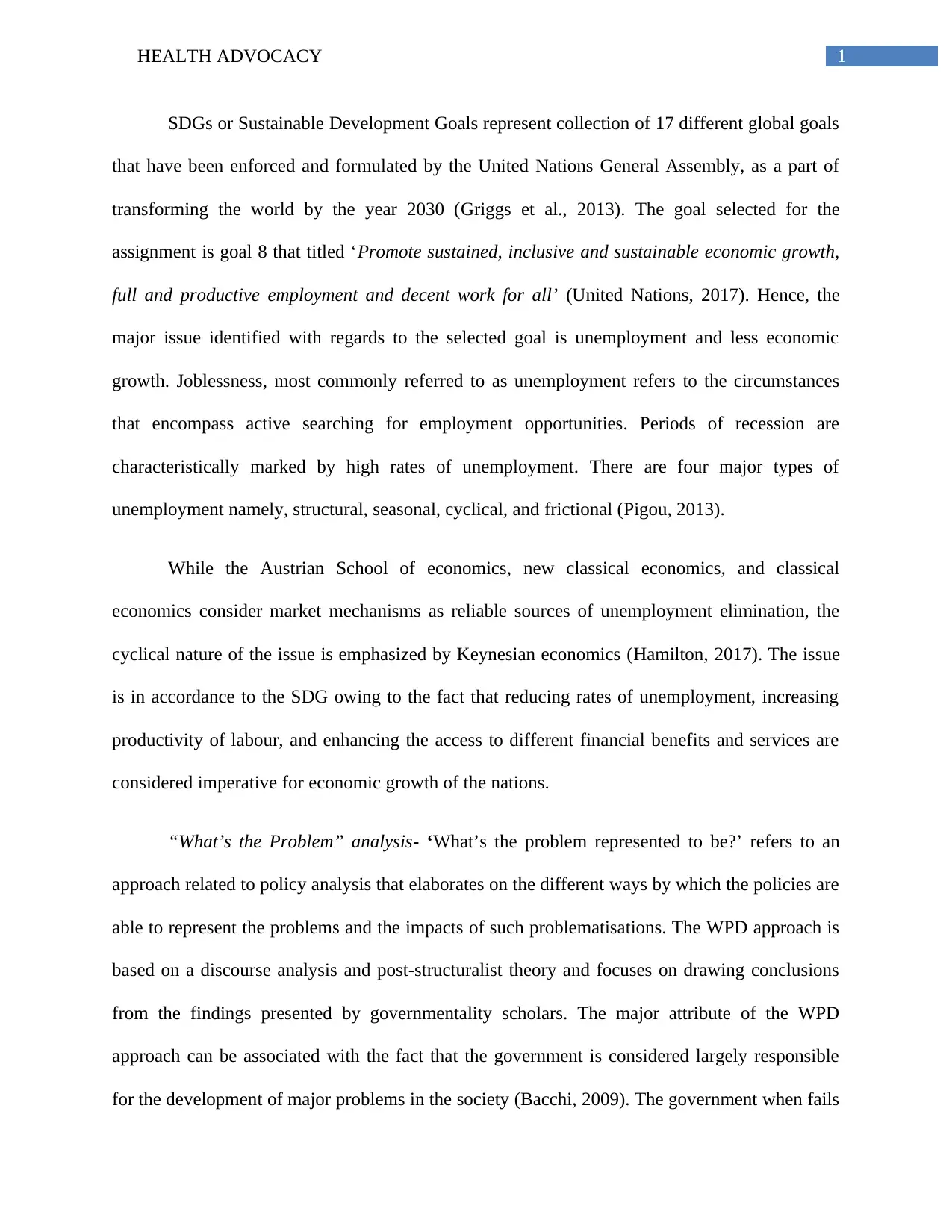
1HEALTH ADVOCACY
SDGs or Sustainable Development Goals represent collection of 17 different global goals
that have been enforced and formulated by the United Nations General Assembly, as a part of
transforming the world by the year 2030 (Griggs et al., 2013). The goal selected for the
assignment is goal 8 that titled ‘Promote sustained, inclusive and sustainable economic growth,
full and productive employment and decent work for all’ (United Nations, 2017). Hence, the
major issue identified with regards to the selected goal is unemployment and less economic
growth. Joblessness, most commonly referred to as unemployment refers to the circumstances
that encompass active searching for employment opportunities. Periods of recession are
characteristically marked by high rates of unemployment. There are four major types of
unemployment namely, structural, seasonal, cyclical, and frictional (Pigou, 2013).
While the Austrian School of economics, new classical economics, and classical
economics consider market mechanisms as reliable sources of unemployment elimination, the
cyclical nature of the issue is emphasized by Keynesian economics (Hamilton, 2017). The issue
is in accordance to the SDG owing to the fact that reducing rates of unemployment, increasing
productivity of labour, and enhancing the access to different financial benefits and services are
considered imperative for economic growth of the nations.
“What’s the Problem” analysis- ‘What’s the problem represented to be?’ refers to an
approach related to policy analysis that elaborates on the different ways by which the policies are
able to represent the problems and the impacts of such problematisations. The WPD approach is
based on a discourse analysis and post-structuralist theory and focuses on drawing conclusions
from the findings presented by governmentality scholars. The major attribute of the WPD
approach can be associated with the fact that the government is considered largely responsible
for the development of major problems in the society (Bacchi, 2009). The government when fails
SDGs or Sustainable Development Goals represent collection of 17 different global goals
that have been enforced and formulated by the United Nations General Assembly, as a part of
transforming the world by the year 2030 (Griggs et al., 2013). The goal selected for the
assignment is goal 8 that titled ‘Promote sustained, inclusive and sustainable economic growth,
full and productive employment and decent work for all’ (United Nations, 2017). Hence, the
major issue identified with regards to the selected goal is unemployment and less economic
growth. Joblessness, most commonly referred to as unemployment refers to the circumstances
that encompass active searching for employment opportunities. Periods of recession are
characteristically marked by high rates of unemployment. There are four major types of
unemployment namely, structural, seasonal, cyclical, and frictional (Pigou, 2013).
While the Austrian School of economics, new classical economics, and classical
economics consider market mechanisms as reliable sources of unemployment elimination, the
cyclical nature of the issue is emphasized by Keynesian economics (Hamilton, 2017). The issue
is in accordance to the SDG owing to the fact that reducing rates of unemployment, increasing
productivity of labour, and enhancing the access to different financial benefits and services are
considered imperative for economic growth of the nations.
“What’s the Problem” analysis- ‘What’s the problem represented to be?’ refers to an
approach related to policy analysis that elaborates on the different ways by which the policies are
able to represent the problems and the impacts of such problematisations. The WPD approach is
based on a discourse analysis and post-structuralist theory and focuses on drawing conclusions
from the findings presented by governmentality scholars. The major attribute of the WPD
approach can be associated with the fact that the government is considered largely responsible
for the development of major problems in the society (Bacchi, 2009). The government when fails
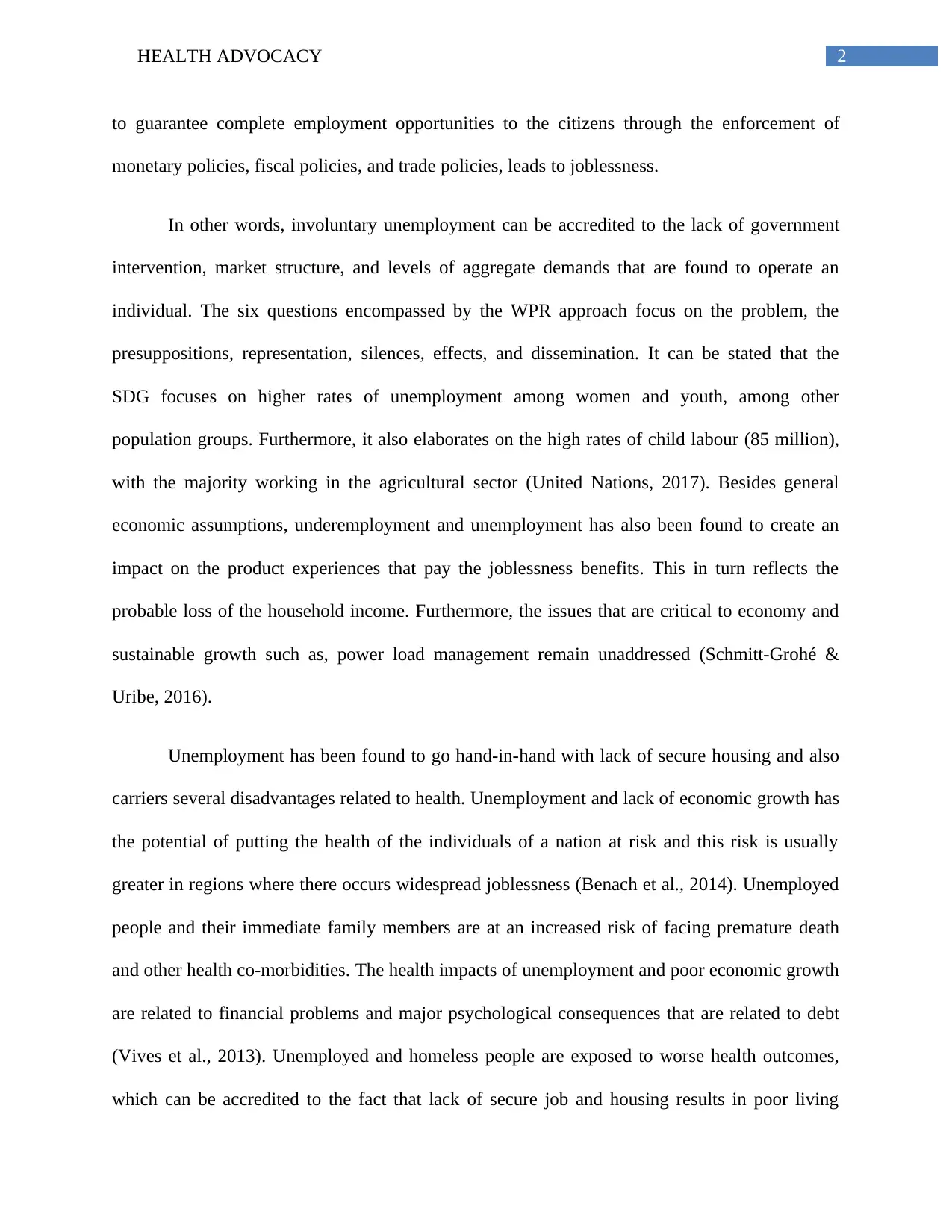
2HEALTH ADVOCACY
to guarantee complete employment opportunities to the citizens through the enforcement of
monetary policies, fiscal policies, and trade policies, leads to joblessness.
In other words, involuntary unemployment can be accredited to the lack of government
intervention, market structure, and levels of aggregate demands that are found to operate an
individual. The six questions encompassed by the WPR approach focus on the problem, the
presuppositions, representation, silences, effects, and dissemination. It can be stated that the
SDG focuses on higher rates of unemployment among women and youth, among other
population groups. Furthermore, it also elaborates on the high rates of child labour (85 million),
with the majority working in the agricultural sector (United Nations, 2017). Besides general
economic assumptions, underemployment and unemployment has also been found to create an
impact on the product experiences that pay the joblessness benefits. This in turn reflects the
probable loss of the household income. Furthermore, the issues that are critical to economy and
sustainable growth such as, power load management remain unaddressed (Schmitt-Grohé &
Uribe, 2016).
Unemployment has been found to go hand-in-hand with lack of secure housing and also
carriers several disadvantages related to health. Unemployment and lack of economic growth has
the potential of putting the health of the individuals of a nation at risk and this risk is usually
greater in regions where there occurs widespread joblessness (Benach et al., 2014). Unemployed
people and their immediate family members are at an increased risk of facing premature death
and other health co-morbidities. The health impacts of unemployment and poor economic growth
are related to financial problems and major psychological consequences that are related to debt
(Vives et al., 2013). Unemployed and homeless people are exposed to worse health outcomes,
which can be accredited to the fact that lack of secure job and housing results in poor living
to guarantee complete employment opportunities to the citizens through the enforcement of
monetary policies, fiscal policies, and trade policies, leads to joblessness.
In other words, involuntary unemployment can be accredited to the lack of government
intervention, market structure, and levels of aggregate demands that are found to operate an
individual. The six questions encompassed by the WPR approach focus on the problem, the
presuppositions, representation, silences, effects, and dissemination. It can be stated that the
SDG focuses on higher rates of unemployment among women and youth, among other
population groups. Furthermore, it also elaborates on the high rates of child labour (85 million),
with the majority working in the agricultural sector (United Nations, 2017). Besides general
economic assumptions, underemployment and unemployment has also been found to create an
impact on the product experiences that pay the joblessness benefits. This in turn reflects the
probable loss of the household income. Furthermore, the issues that are critical to economy and
sustainable growth such as, power load management remain unaddressed (Schmitt-Grohé &
Uribe, 2016).
Unemployment has been found to go hand-in-hand with lack of secure housing and also
carriers several disadvantages related to health. Unemployment and lack of economic growth has
the potential of putting the health of the individuals of a nation at risk and this risk is usually
greater in regions where there occurs widespread joblessness (Benach et al., 2014). Unemployed
people and their immediate family members are at an increased risk of facing premature death
and other health co-morbidities. The health impacts of unemployment and poor economic growth
are related to financial problems and major psychological consequences that are related to debt
(Vives et al., 2013). Unemployed and homeless people are exposed to worse health outcomes,
which can be accredited to the fact that lack of secure job and housing results in poor living
⊘ This is a preview!⊘
Do you want full access?
Subscribe today to unlock all pages.

Trusted by 1+ million students worldwide
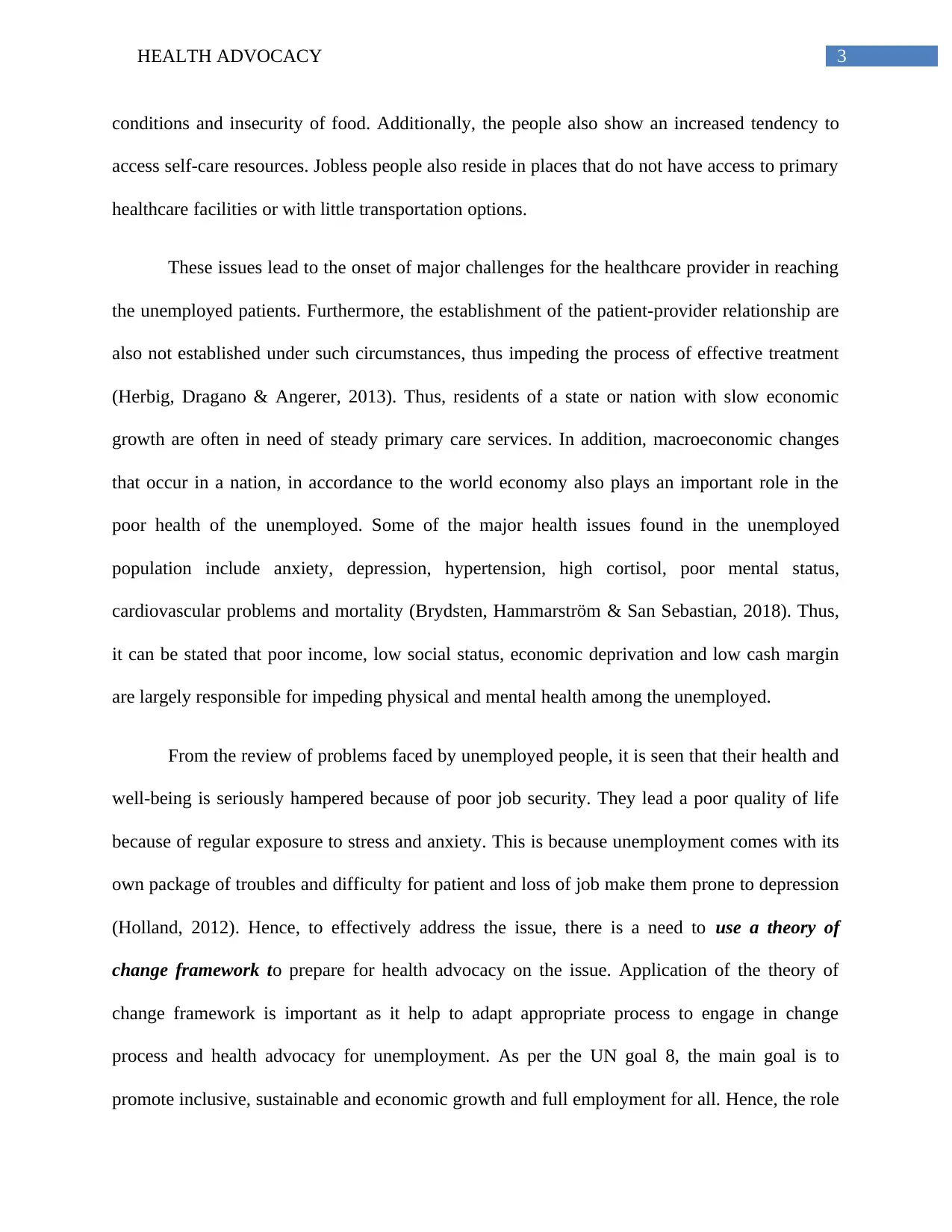
3HEALTH ADVOCACY
conditions and insecurity of food. Additionally, the people also show an increased tendency to
access self-care resources. Jobless people also reside in places that do not have access to primary
healthcare facilities or with little transportation options.
These issues lead to the onset of major challenges for the healthcare provider in reaching
the unemployed patients. Furthermore, the establishment of the patient-provider relationship are
also not established under such circumstances, thus impeding the process of effective treatment
(Herbig, Dragano & Angerer, 2013). Thus, residents of a state or nation with slow economic
growth are often in need of steady primary care services. In addition, macroeconomic changes
that occur in a nation, in accordance to the world economy also plays an important role in the
poor health of the unemployed. Some of the major health issues found in the unemployed
population include anxiety, depression, hypertension, high cortisol, poor mental status,
cardiovascular problems and mortality (Brydsten, Hammarström & San Sebastian, 2018). Thus,
it can be stated that poor income, low social status, economic deprivation and low cash margin
are largely responsible for impeding physical and mental health among the unemployed.
From the review of problems faced by unemployed people, it is seen that their health and
well-being is seriously hampered because of poor job security. They lead a poor quality of life
because of regular exposure to stress and anxiety. This is because unemployment comes with its
own package of troubles and difficulty for patient and loss of job make them prone to depression
(Holland, 2012). Hence, to effectively address the issue, there is a need to use a theory of
change framework to prepare for health advocacy on the issue. Application of the theory of
change framework is important as it help to adapt appropriate process to engage in change
process and health advocacy for unemployment. As per the UN goal 8, the main goal is to
promote inclusive, sustainable and economic growth and full employment for all. Hence, the role
conditions and insecurity of food. Additionally, the people also show an increased tendency to
access self-care resources. Jobless people also reside in places that do not have access to primary
healthcare facilities or with little transportation options.
These issues lead to the onset of major challenges for the healthcare provider in reaching
the unemployed patients. Furthermore, the establishment of the patient-provider relationship are
also not established under such circumstances, thus impeding the process of effective treatment
(Herbig, Dragano & Angerer, 2013). Thus, residents of a state or nation with slow economic
growth are often in need of steady primary care services. In addition, macroeconomic changes
that occur in a nation, in accordance to the world economy also plays an important role in the
poor health of the unemployed. Some of the major health issues found in the unemployed
population include anxiety, depression, hypertension, high cortisol, poor mental status,
cardiovascular problems and mortality (Brydsten, Hammarström & San Sebastian, 2018). Thus,
it can be stated that poor income, low social status, economic deprivation and low cash margin
are largely responsible for impeding physical and mental health among the unemployed.
From the review of problems faced by unemployed people, it is seen that their health and
well-being is seriously hampered because of poor job security. They lead a poor quality of life
because of regular exposure to stress and anxiety. This is because unemployment comes with its
own package of troubles and difficulty for patient and loss of job make them prone to depression
(Holland, 2012). Hence, to effectively address the issue, there is a need to use a theory of
change framework to prepare for health advocacy on the issue. Application of the theory of
change framework is important as it help to adapt appropriate process to engage in change
process and health advocacy for unemployment. As per the UN goal 8, the main goal is to
promote inclusive, sustainable and economic growth and full employment for all. Hence, the role
Paraphrase This Document
Need a fresh take? Get an instant paraphrase of this document with our AI Paraphraser
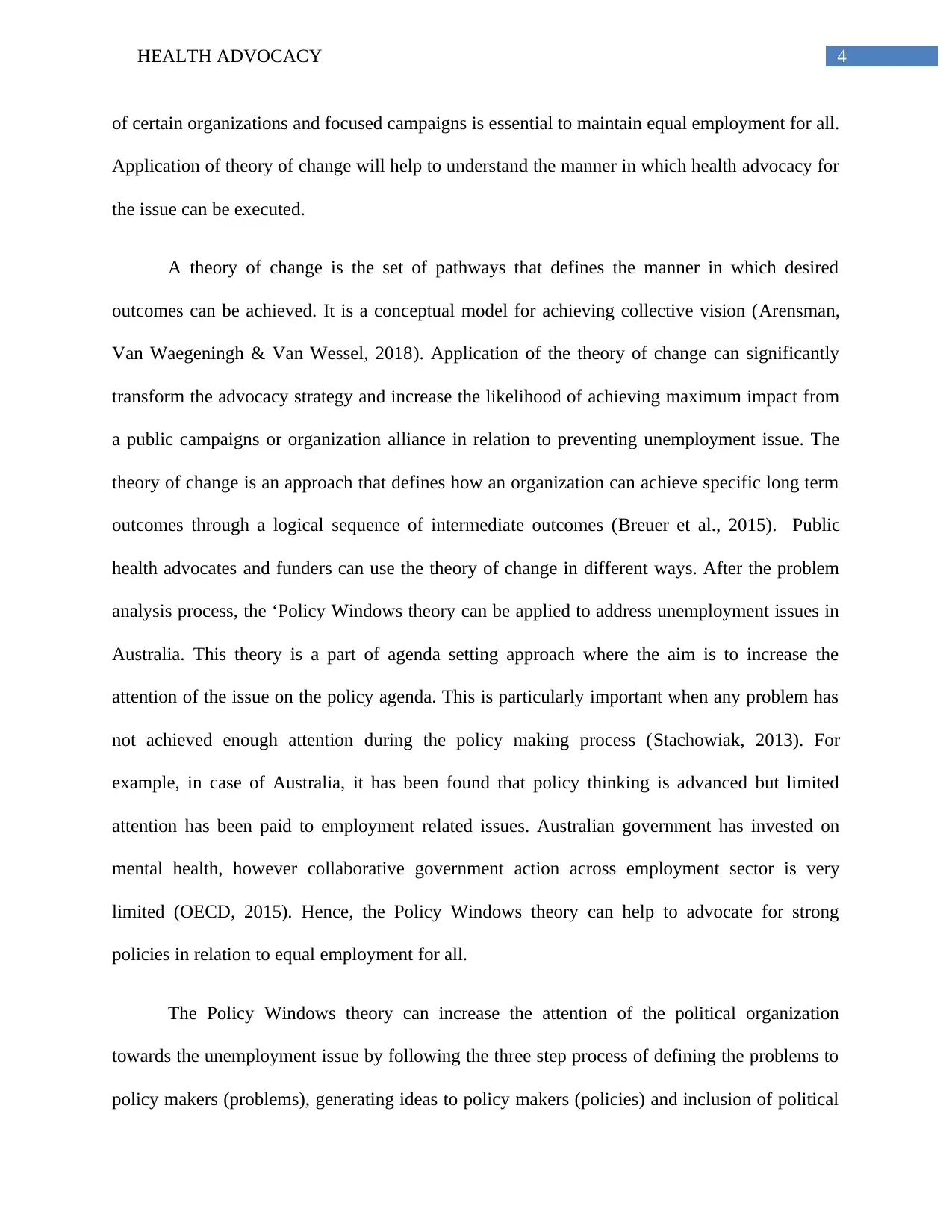
4HEALTH ADVOCACY
of certain organizations and focused campaigns is essential to maintain equal employment for all.
Application of theory of change will help to understand the manner in which health advocacy for
the issue can be executed.
A theory of change is the set of pathways that defines the manner in which desired
outcomes can be achieved. It is a conceptual model for achieving collective vision (Arensman,
Van Waegeningh & Van Wessel, 2018). Application of the theory of change can significantly
transform the advocacy strategy and increase the likelihood of achieving maximum impact from
a public campaigns or organization alliance in relation to preventing unemployment issue. The
theory of change is an approach that defines how an organization can achieve specific long term
outcomes through a logical sequence of intermediate outcomes (Breuer et al., 2015). Public
health advocates and funders can use the theory of change in different ways. After the problem
analysis process, the ‘Policy Windows theory can be applied to address unemployment issues in
Australia. This theory is a part of agenda setting approach where the aim is to increase the
attention of the issue on the policy agenda. This is particularly important when any problem has
not achieved enough attention during the policy making process (Stachowiak, 2013). For
example, in case of Australia, it has been found that policy thinking is advanced but limited
attention has been paid to employment related issues. Australian government has invested on
mental health, however collaborative government action across employment sector is very
limited (OECD, 2015). Hence, the Policy Windows theory can help to advocate for strong
policies in relation to equal employment for all.
The Policy Windows theory can increase the attention of the political organization
towards the unemployment issue by following the three step process of defining the problems to
policy makers (problems), generating ideas to policy makers (policies) and inclusion of political
of certain organizations and focused campaigns is essential to maintain equal employment for all.
Application of theory of change will help to understand the manner in which health advocacy for
the issue can be executed.
A theory of change is the set of pathways that defines the manner in which desired
outcomes can be achieved. It is a conceptual model for achieving collective vision (Arensman,
Van Waegeningh & Van Wessel, 2018). Application of the theory of change can significantly
transform the advocacy strategy and increase the likelihood of achieving maximum impact from
a public campaigns or organization alliance in relation to preventing unemployment issue. The
theory of change is an approach that defines how an organization can achieve specific long term
outcomes through a logical sequence of intermediate outcomes (Breuer et al., 2015). Public
health advocates and funders can use the theory of change in different ways. After the problem
analysis process, the ‘Policy Windows theory can be applied to address unemployment issues in
Australia. This theory is a part of agenda setting approach where the aim is to increase the
attention of the issue on the policy agenda. This is particularly important when any problem has
not achieved enough attention during the policy making process (Stachowiak, 2013). For
example, in case of Australia, it has been found that policy thinking is advanced but limited
attention has been paid to employment related issues. Australian government has invested on
mental health, however collaborative government action across employment sector is very
limited (OECD, 2015). Hence, the Policy Windows theory can help to advocate for strong
policies in relation to equal employment for all.
The Policy Windows theory can increase the attention of the political organization
towards the unemployment issue by following the three step process of defining the problems to
policy makers (problems), generating ideas to policy makers (policies) and inclusion of political
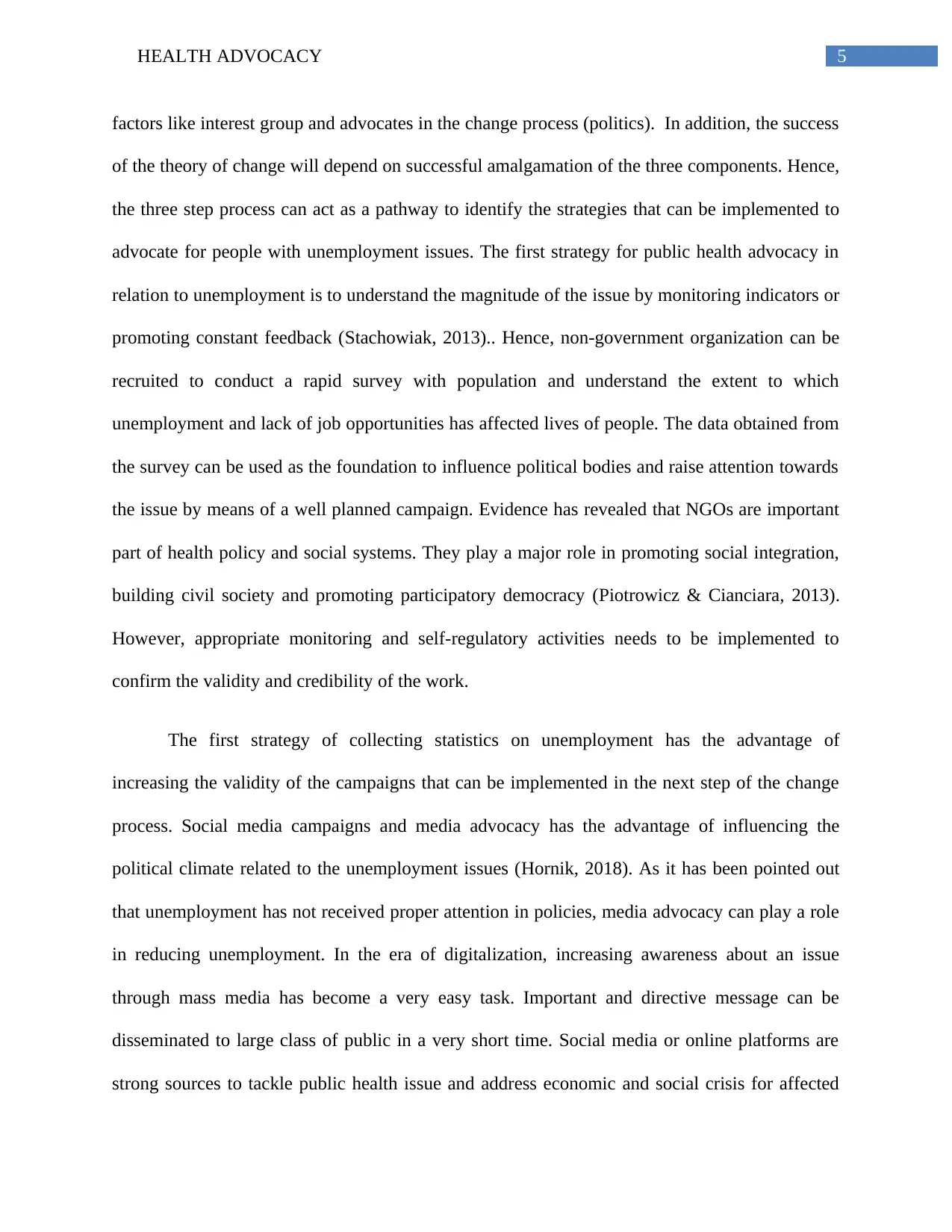
5HEALTH ADVOCACY
factors like interest group and advocates in the change process (politics). In addition, the success
of the theory of change will depend on successful amalgamation of the three components. Hence,
the three step process can act as a pathway to identify the strategies that can be implemented to
advocate for people with unemployment issues. The first strategy for public health advocacy in
relation to unemployment is to understand the magnitude of the issue by monitoring indicators or
promoting constant feedback (Stachowiak, 2013).. Hence, non-government organization can be
recruited to conduct a rapid survey with population and understand the extent to which
unemployment and lack of job opportunities has affected lives of people. The data obtained from
the survey can be used as the foundation to influence political bodies and raise attention towards
the issue by means of a well planned campaign. Evidence has revealed that NGOs are important
part of health policy and social systems. They play a major role in promoting social integration,
building civil society and promoting participatory democracy (Piotrowicz & Cianciara, 2013).
However, appropriate monitoring and self-regulatory activities needs to be implemented to
confirm the validity and credibility of the work.
The first strategy of collecting statistics on unemployment has the advantage of
increasing the validity of the campaigns that can be implemented in the next step of the change
process. Social media campaigns and media advocacy has the advantage of influencing the
political climate related to the unemployment issues (Hornik, 2018). As it has been pointed out
that unemployment has not received proper attention in policies, media advocacy can play a role
in reducing unemployment. In the era of digitalization, increasing awareness about an issue
through mass media has become a very easy task. Important and directive message can be
disseminated to large class of public in a very short time. Social media or online platforms are
strong sources to tackle public health issue and address economic and social crisis for affected
factors like interest group and advocates in the change process (politics). In addition, the success
of the theory of change will depend on successful amalgamation of the three components. Hence,
the three step process can act as a pathway to identify the strategies that can be implemented to
advocate for people with unemployment issues. The first strategy for public health advocacy in
relation to unemployment is to understand the magnitude of the issue by monitoring indicators or
promoting constant feedback (Stachowiak, 2013).. Hence, non-government organization can be
recruited to conduct a rapid survey with population and understand the extent to which
unemployment and lack of job opportunities has affected lives of people. The data obtained from
the survey can be used as the foundation to influence political bodies and raise attention towards
the issue by means of a well planned campaign. Evidence has revealed that NGOs are important
part of health policy and social systems. They play a major role in promoting social integration,
building civil society and promoting participatory democracy (Piotrowicz & Cianciara, 2013).
However, appropriate monitoring and self-regulatory activities needs to be implemented to
confirm the validity and credibility of the work.
The first strategy of collecting statistics on unemployment has the advantage of
increasing the validity of the campaigns that can be implemented in the next step of the change
process. Social media campaigns and media advocacy has the advantage of influencing the
political climate related to the unemployment issues (Hornik, 2018). As it has been pointed out
that unemployment has not received proper attention in policies, media advocacy can play a role
in reducing unemployment. In the era of digitalization, increasing awareness about an issue
through mass media has become a very easy task. Important and directive message can be
disseminated to large class of public in a very short time. Social media or online platforms are
strong sources to tackle public health issue and address economic and social crisis for affected
⊘ This is a preview!⊘
Do you want full access?
Subscribe today to unlock all pages.

Trusted by 1+ million students worldwide
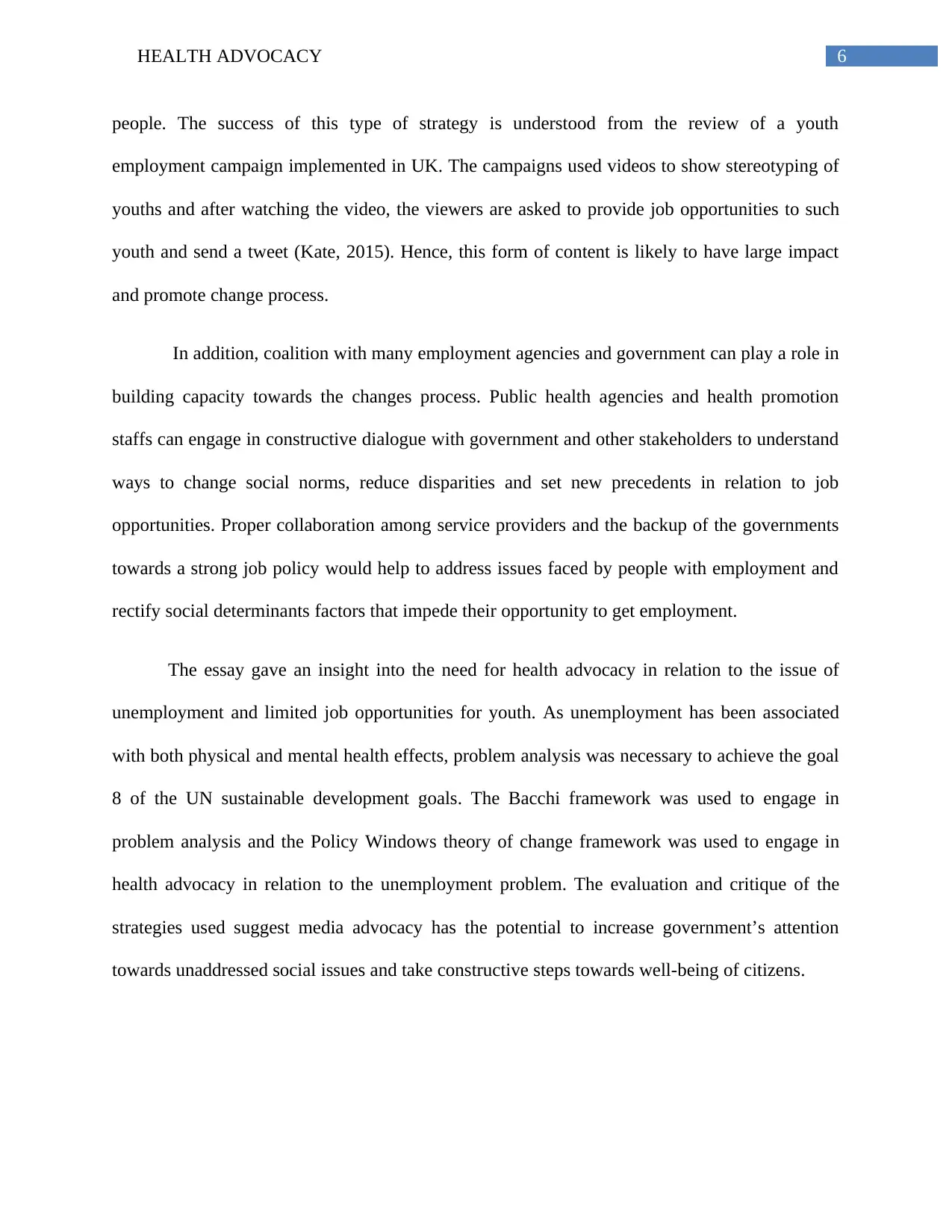
6HEALTH ADVOCACY
people. The success of this type of strategy is understood from the review of a youth
employment campaign implemented in UK. The campaigns used videos to show stereotyping of
youths and after watching the video, the viewers are asked to provide job opportunities to such
youth and send a tweet (Kate, 2015). Hence, this form of content is likely to have large impact
and promote change process.
In addition, coalition with many employment agencies and government can play a role in
building capacity towards the changes process. Public health agencies and health promotion
staffs can engage in constructive dialogue with government and other stakeholders to understand
ways to change social norms, reduce disparities and set new precedents in relation to job
opportunities. Proper collaboration among service providers and the backup of the governments
towards a strong job policy would help to address issues faced by people with employment and
rectify social determinants factors that impede their opportunity to get employment.
The essay gave an insight into the need for health advocacy in relation to the issue of
unemployment and limited job opportunities for youth. As unemployment has been associated
with both physical and mental health effects, problem analysis was necessary to achieve the goal
8 of the UN sustainable development goals. The Bacchi framework was used to engage in
problem analysis and the Policy Windows theory of change framework was used to engage in
health advocacy in relation to the unemployment problem. The evaluation and critique of the
strategies used suggest media advocacy has the potential to increase government’s attention
towards unaddressed social issues and take constructive steps towards well-being of citizens.
people. The success of this type of strategy is understood from the review of a youth
employment campaign implemented in UK. The campaigns used videos to show stereotyping of
youths and after watching the video, the viewers are asked to provide job opportunities to such
youth and send a tweet (Kate, 2015). Hence, this form of content is likely to have large impact
and promote change process.
In addition, coalition with many employment agencies and government can play a role in
building capacity towards the changes process. Public health agencies and health promotion
staffs can engage in constructive dialogue with government and other stakeholders to understand
ways to change social norms, reduce disparities and set new precedents in relation to job
opportunities. Proper collaboration among service providers and the backup of the governments
towards a strong job policy would help to address issues faced by people with employment and
rectify social determinants factors that impede their opportunity to get employment.
The essay gave an insight into the need for health advocacy in relation to the issue of
unemployment and limited job opportunities for youth. As unemployment has been associated
with both physical and mental health effects, problem analysis was necessary to achieve the goal
8 of the UN sustainable development goals. The Bacchi framework was used to engage in
problem analysis and the Policy Windows theory of change framework was used to engage in
health advocacy in relation to the unemployment problem. The evaluation and critique of the
strategies used suggest media advocacy has the potential to increase government’s attention
towards unaddressed social issues and take constructive steps towards well-being of citizens.
Paraphrase This Document
Need a fresh take? Get an instant paraphrase of this document with our AI Paraphraser
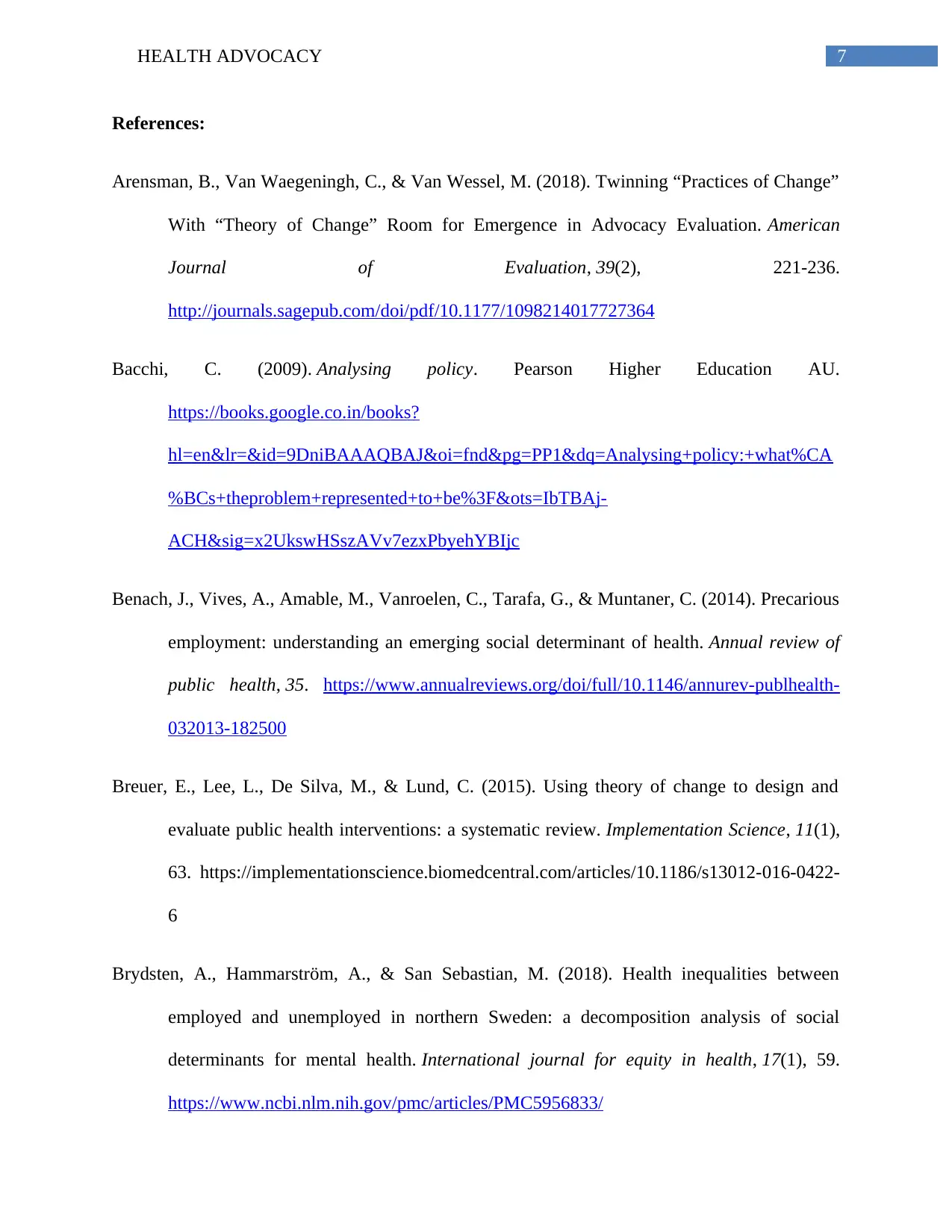
7HEALTH ADVOCACY
References:
Arensman, B., Van Waegeningh, C., & Van Wessel, M. (2018). Twinning “Practices of Change”
With “Theory of Change” Room for Emergence in Advocacy Evaluation. American
Journal of Evaluation, 39(2), 221-236.
http://journals.sagepub.com/doi/pdf/10.1177/1098214017727364
Bacchi, C. (2009). Analysing policy. Pearson Higher Education AU.
https://books.google.co.in/books?
hl=en&lr=&id=9DniBAAAQBAJ&oi=fnd&pg=PP1&dq=Analysing+policy:+what%CA
%BCs+theproblem+represented+to+be%3F&ots=IbTBAj-
ACH&sig=x2UkswHSszAVv7ezxPbyehYBIjc
Benach, J., Vives, A., Amable, M., Vanroelen, C., Tarafa, G., & Muntaner, C. (2014). Precarious
employment: understanding an emerging social determinant of health. Annual review of
public health, 35. https://www.annualreviews.org/doi/full/10.1146/annurev-publhealth-
032013-182500
Breuer, E., Lee, L., De Silva, M., & Lund, C. (2015). Using theory of change to design and
evaluate public health interventions: a systematic review. Implementation Science, 11(1),
63. https://implementationscience.biomedcentral.com/articles/10.1186/s13012-016-0422-
6
Brydsten, A., Hammarström, A., & San Sebastian, M. (2018). Health inequalities between
employed and unemployed in northern Sweden: a decomposition analysis of social
determinants for mental health. International journal for equity in health, 17(1), 59.
https://www.ncbi.nlm.nih.gov/pmc/articles/PMC5956833/
References:
Arensman, B., Van Waegeningh, C., & Van Wessel, M. (2018). Twinning “Practices of Change”
With “Theory of Change” Room for Emergence in Advocacy Evaluation. American
Journal of Evaluation, 39(2), 221-236.
http://journals.sagepub.com/doi/pdf/10.1177/1098214017727364
Bacchi, C. (2009). Analysing policy. Pearson Higher Education AU.
https://books.google.co.in/books?
hl=en&lr=&id=9DniBAAAQBAJ&oi=fnd&pg=PP1&dq=Analysing+policy:+what%CA
%BCs+theproblem+represented+to+be%3F&ots=IbTBAj-
ACH&sig=x2UkswHSszAVv7ezxPbyehYBIjc
Benach, J., Vives, A., Amable, M., Vanroelen, C., Tarafa, G., & Muntaner, C. (2014). Precarious
employment: understanding an emerging social determinant of health. Annual review of
public health, 35. https://www.annualreviews.org/doi/full/10.1146/annurev-publhealth-
032013-182500
Breuer, E., Lee, L., De Silva, M., & Lund, C. (2015). Using theory of change to design and
evaluate public health interventions: a systematic review. Implementation Science, 11(1),
63. https://implementationscience.biomedcentral.com/articles/10.1186/s13012-016-0422-
6
Brydsten, A., Hammarström, A., & San Sebastian, M. (2018). Health inequalities between
employed and unemployed in northern Sweden: a decomposition analysis of social
determinants for mental health. International journal for equity in health, 17(1), 59.
https://www.ncbi.nlm.nih.gov/pmc/articles/PMC5956833/
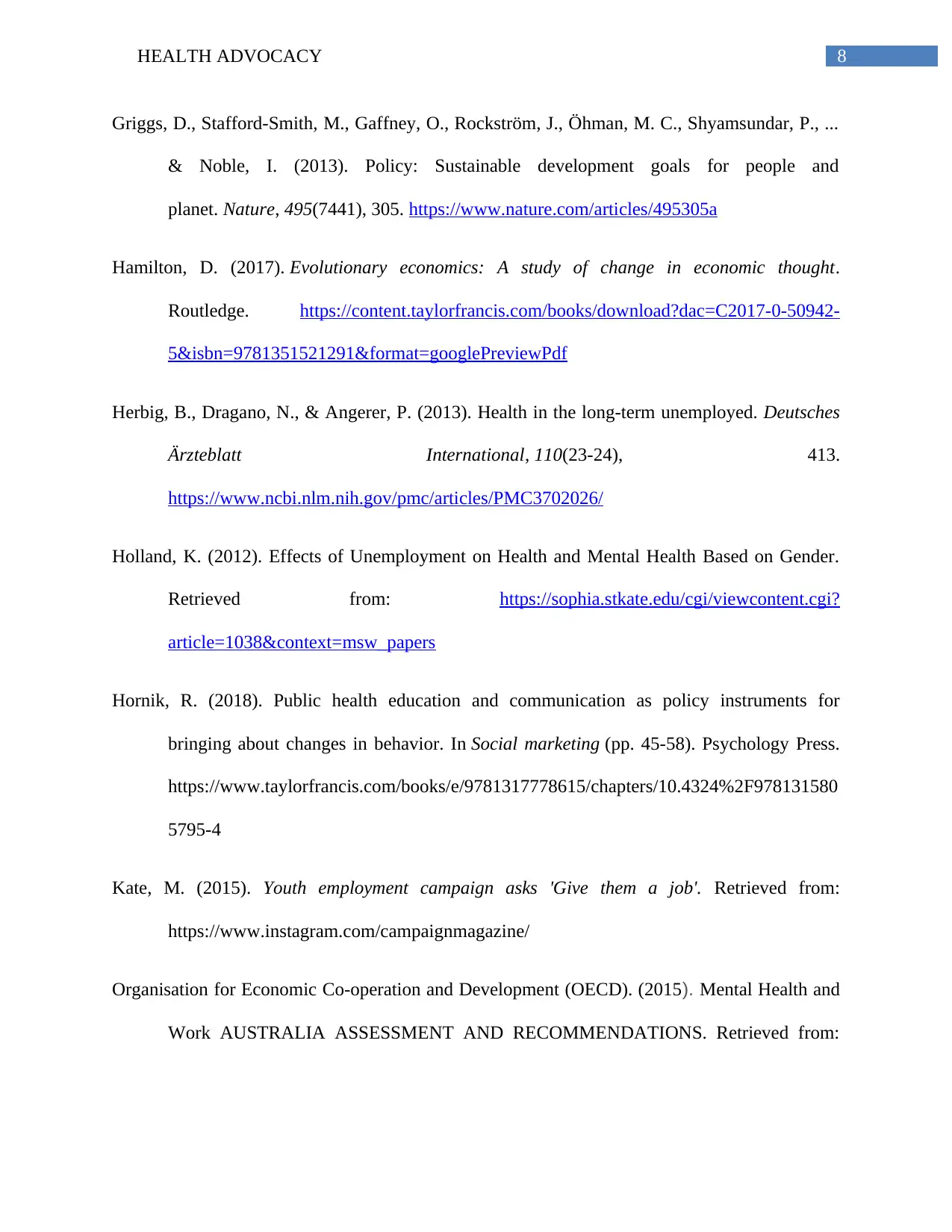
8HEALTH ADVOCACY
Griggs, D., Stafford-Smith, M., Gaffney, O., Rockström, J., Öhman, M. C., Shyamsundar, P., ...
& Noble, I. (2013). Policy: Sustainable development goals for people and
planet. Nature, 495(7441), 305. https://www.nature.com/articles/495305a
Hamilton, D. (2017). Evolutionary economics: A study of change in economic thought.
Routledge. https://content.taylorfrancis.com/books/download?dac=C2017-0-50942-
5&isbn=9781351521291&format=googlePreviewPdf
Herbig, B., Dragano, N., & Angerer, P. (2013). Health in the long-term unemployed. Deutsches
Ärzteblatt International, 110(23-24), 413.
https://www.ncbi.nlm.nih.gov/pmc/articles/PMC3702026/
Holland, K. (2012). Effects of Unemployment on Health and Mental Health Based on Gender.
Retrieved from: https://sophia.stkate.edu/cgi/viewcontent.cgi?
article=1038&context=msw_papers
Hornik, R. (2018). Public health education and communication as policy instruments for
bringing about changes in behavior. In Social marketing (pp. 45-58). Psychology Press.
https://www.taylorfrancis.com/books/e/9781317778615/chapters/10.4324%2F978131580
5795-4
Kate, M. (2015). Youth employment campaign asks 'Give them a job'. Retrieved from:
https://www.instagram.com/campaignmagazine/
Organisation for Economic Co-operation and Development (OECD). (2015). Mental Health and
Work AUSTRALIA ASSESSMENT AND RECOMMENDATIONS. Retrieved from:
Griggs, D., Stafford-Smith, M., Gaffney, O., Rockström, J., Öhman, M. C., Shyamsundar, P., ...
& Noble, I. (2013). Policy: Sustainable development goals for people and
planet. Nature, 495(7441), 305. https://www.nature.com/articles/495305a
Hamilton, D. (2017). Evolutionary economics: A study of change in economic thought.
Routledge. https://content.taylorfrancis.com/books/download?dac=C2017-0-50942-
5&isbn=9781351521291&format=googlePreviewPdf
Herbig, B., Dragano, N., & Angerer, P. (2013). Health in the long-term unemployed. Deutsches
Ärzteblatt International, 110(23-24), 413.
https://www.ncbi.nlm.nih.gov/pmc/articles/PMC3702026/
Holland, K. (2012). Effects of Unemployment on Health and Mental Health Based on Gender.
Retrieved from: https://sophia.stkate.edu/cgi/viewcontent.cgi?
article=1038&context=msw_papers
Hornik, R. (2018). Public health education and communication as policy instruments for
bringing about changes in behavior. In Social marketing (pp. 45-58). Psychology Press.
https://www.taylorfrancis.com/books/e/9781317778615/chapters/10.4324%2F978131580
5795-4
Kate, M. (2015). Youth employment campaign asks 'Give them a job'. Retrieved from:
https://www.instagram.com/campaignmagazine/
Organisation for Economic Co-operation and Development (OECD). (2015). Mental Health and
Work AUSTRALIA ASSESSMENT AND RECOMMENDATIONS. Retrieved from:
⊘ This is a preview!⊘
Do you want full access?
Subscribe today to unlock all pages.

Trusted by 1+ million students worldwide
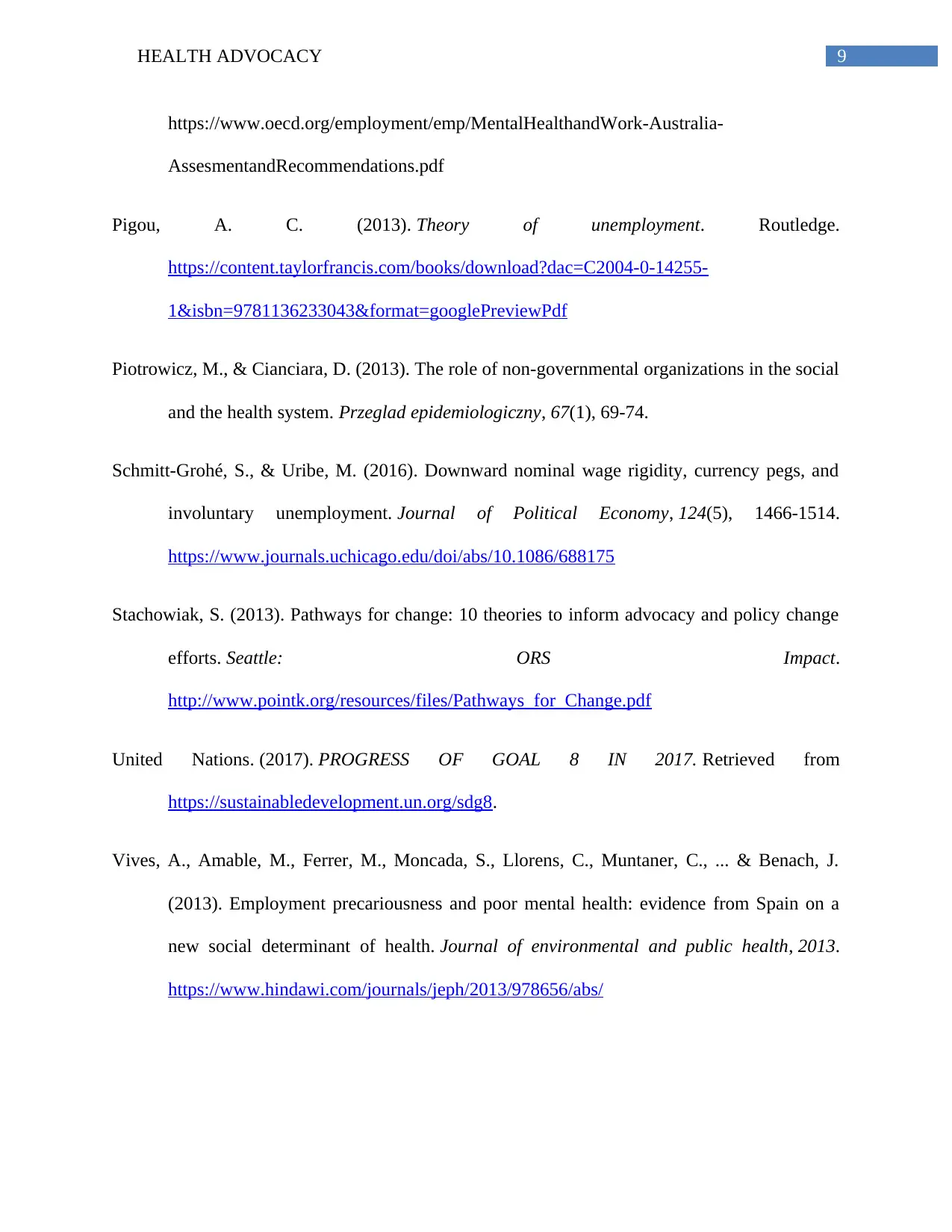
9HEALTH ADVOCACY
https://www.oecd.org/employment/emp/MentalHealthandWork-Australia-
AssesmentandRecommendations.pdf
Pigou, A. C. (2013). Theory of unemployment. Routledge.
https://content.taylorfrancis.com/books/download?dac=C2004-0-14255-
1&isbn=9781136233043&format=googlePreviewPdf
Piotrowicz, M., & Cianciara, D. (2013). The role of non-governmental organizations in the social
and the health system. Przeglad epidemiologiczny, 67(1), 69-74.
Schmitt-Grohé, S., & Uribe, M. (2016). Downward nominal wage rigidity, currency pegs, and
involuntary unemployment. Journal of Political Economy, 124(5), 1466-1514.
https://www.journals.uchicago.edu/doi/abs/10.1086/688175
Stachowiak, S. (2013). Pathways for change: 10 theories to inform advocacy and policy change
efforts. Seattle: ORS Impact.
http://www.pointk.org/resources/files/Pathways_for_Change.pdf
United Nations. (2017). PROGRESS OF GOAL 8 IN 2017. Retrieved from
https://sustainabledevelopment.un.org/sdg8.
Vives, A., Amable, M., Ferrer, M., Moncada, S., Llorens, C., Muntaner, C., ... & Benach, J.
(2013). Employment precariousness and poor mental health: evidence from Spain on a
new social determinant of health. Journal of environmental and public health, 2013.
https://www.hindawi.com/journals/jeph/2013/978656/abs/
https://www.oecd.org/employment/emp/MentalHealthandWork-Australia-
AssesmentandRecommendations.pdf
Pigou, A. C. (2013). Theory of unemployment. Routledge.
https://content.taylorfrancis.com/books/download?dac=C2004-0-14255-
1&isbn=9781136233043&format=googlePreviewPdf
Piotrowicz, M., & Cianciara, D. (2013). The role of non-governmental organizations in the social
and the health system. Przeglad epidemiologiczny, 67(1), 69-74.
Schmitt-Grohé, S., & Uribe, M. (2016). Downward nominal wage rigidity, currency pegs, and
involuntary unemployment. Journal of Political Economy, 124(5), 1466-1514.
https://www.journals.uchicago.edu/doi/abs/10.1086/688175
Stachowiak, S. (2013). Pathways for change: 10 theories to inform advocacy and policy change
efforts. Seattle: ORS Impact.
http://www.pointk.org/resources/files/Pathways_for_Change.pdf
United Nations. (2017). PROGRESS OF GOAL 8 IN 2017. Retrieved from
https://sustainabledevelopment.un.org/sdg8.
Vives, A., Amable, M., Ferrer, M., Moncada, S., Llorens, C., Muntaner, C., ... & Benach, J.
(2013). Employment precariousness and poor mental health: evidence from Spain on a
new social determinant of health. Journal of environmental and public health, 2013.
https://www.hindawi.com/journals/jeph/2013/978656/abs/
1 out of 10
Related Documents
Your All-in-One AI-Powered Toolkit for Academic Success.
+13062052269
info@desklib.com
Available 24*7 on WhatsApp / Email
![[object Object]](/_next/static/media/star-bottom.7253800d.svg)
Unlock your academic potential
Copyright © 2020–2025 A2Z Services. All Rights Reserved. Developed and managed by ZUCOL.





